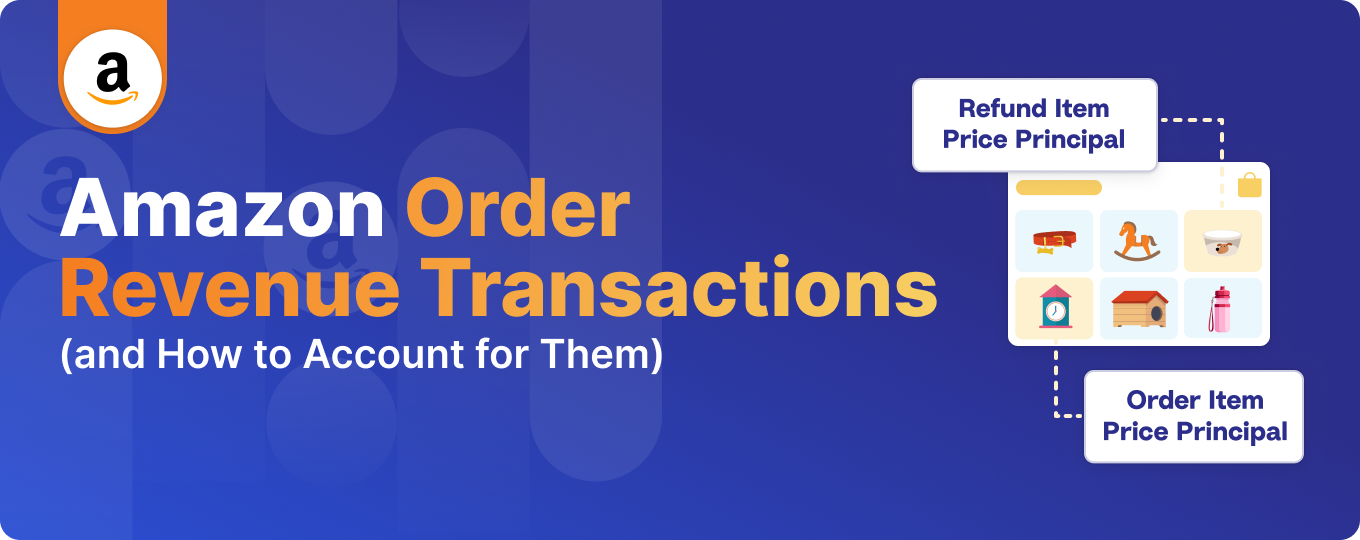Amazon Order Revenue Transactions (and How to Account for Them)
Written by: Elspeth Cordray

One of the biggest bookkeeping mistakes that Amazon sellers make is recording their entire settlement bank deposit as “income” – when, in fact, it’s actually a combination of sales and other fees and transactions associated with selling on Amazon.
We’ve put together a comprehensive list of Amazon seller fees and transactions that can help you familiarize yourself with some of the transactions you might see on your Amazon seller statement. Properly accounting for each transaction is critical for keeping accurate financial records, which can help you get better insights about your marketplace, and even secure investments or loans.
One of the categories of Amazon transactions that sellers will be most interested in is “order revenue” transactions – i.e., transactions that impact revenue. In this post, we’ll provide a deep dive into how to identify, record and account for Amazon order revenue transactions.
Key takeaways:
- Amazon order revenue transactions include all financial exchanges related to selling a product on Amazon. These transactions impact revenue and can involve more than just sales, such as refunds, promotions, and shipping charges.
- Key transaction types include “Item Price Principal” (original selling price), “Refund Item Price Principal” (refunded sales price), “Order Promotion Principal” (discounted price on an item), and “A-to-z Guarantee Refund” (refunds covered under Amazon’s buyer protection policy).
- Properly categorizing revenue transactions helps sellers maintain a clear financial picture, make informed business decisions, and ensure accurate tax reporting. Misclassifying transactions can lead to errors in financial statements, potential tax issues, and difficulty securing loans or investments.
What are Amazon order revenue transactions?
Amazon order revenue transactions represent all financial exchanges that occur when a product is sold on the Amazon platform.
These transactions can be straightforward, such as the sale of an item, or more complex, involving refunds, promotions, adjustments, and guarantees.
Identifying Amazon order revenue transactions
You can find a breakdown of all your storefront’s different transactions in the Amazon Seller Central dashboard. Or, you can use A2X – which can make accounting and bookkeeping for all of these different transactions easy (see instructions below).
A simple way to identify a revenue-related transaction is to look for the terms “Item Price” or “Item Price Principal”. Both of these terms refer to the original price of the product, before any promotions, shipping charges, etc. are applied.
Some examples of Amazon transactions that can affect order revenue include:
Refund Item Price Goodwill | A goodwill refund given to a customer, deducted from Amazon's or the seller's account. |
Order Promotion Principal and Refund Promotion Principal | Discounts on the item being sold (Principal) or shipping. |
Order Item Price Principal | The original selling price of an ordered item. |
Refund Item Price Principal | The refunded selling price of an item. |
A-to-z Guarantee Refund Item Price Principal | The selling price refunded to the buyer under Amazon Pay's A-to-z Guarantee. |
Order Item Price Shipping | Shipping charges for items bought through Amazon. |
Refund Item Price Return Shipping | Compensation for shipping costs when a buyer returns a refunded item. |
Refund Item Price Shipping | Compensation for shipping on a refunded item. |
Refund Promotion Shipping | Refund on shipping for a returned, promoted item. |
Be sure to consult Amazon Seller Central for more information about particular transactions that relate to your store.
Why does accurate accounting matter?
You might be thinking, “If all of these transactions impact revenue, can’t I just record them all as ‘income’ and call it a day?”
You could. However, the volume of transactions and trying to make sense of Amazon’s settlement reports can be daunting and time-consuming. Additionally, this won’t give you a true picture of your income – for example, have your sales decreased, or are you instead issuing more refunds?
You also want to make sure you’re recording transactions as accurately as possible. As you can see from the list of example transactions above, each transaction relates to a specific action, activity, or detail in your Amazon account. Having a way to easily identify and accurately reconcile these transactions into your accounting system can help you achieve:
- A clear picture of your finances: By categorizing each transaction, sellers can easily identify where most of their revenue and expenses come from.
- Accurate tax reporting: Some of these categories might have different tax implications. For example, shipping expenses might be deductible, whereas shipping revenue is taxable. Consult an ecommerce accountant to better understand tax responsibilities.
- Informed decision making: Understanding areas like which promotions lead to more sales or how often the A-to-z Guarantee is used can help sellers modify their strategies.
- Enhanced inventory management: Knowing specifics about sales, returns, and refunds helps in making informed decisions about stock levels.
- Better dispute management: In case of any discrepancies with Amazon or customers, having detailed transaction records can help to resolve disputes.
Accounting for Amazon revenue transactions using A2X
A2X can help you record and reconcile all your Amazon store’s transactions in your accounting software (e.g., QuickBooks Online or Xero) quickly and easily. A2X also has a filter that can show you all of your income or revenue transaction types.
Here’s a quick overview that explains more:
Follow the steps below to account for your Amazon store’s transactions with A2X.
1. Set up A2X
If you haven’t already, sign up for A2X and connect it to your accounting software. Follow the on-screen prompts or check A2X’s support center for guidance.
Then, connect to Amazon Seller Central. A2X will automatically fetch your Amazon settlement data.
2. Map transaction types to accounts
For accurate accounting, you need to map Amazon transaction types to corresponding accounts in your accounting software.
In A2X, go to the ‘Accounts & Taxes’ tab.
A2X can automatically map your accounts for you. Follow the prompts to answer the questionnaire that will help set up your account mappings, then choose the ‘Default’ setup to automatically set these up. (Note – if you want to change any of A2X’s default mappings to a specific account, you can update this after the default setup.)
Here’s how A2X would typically map the example transaction types that we provided above. Important: We recommend working with a specialized ecommerce accountant to make sure you have mapping set up correctly for your specific business needs.
Amazon Transaction | A2X Default Account | Account Type |
Refund Item Price Goodwill | Amazon Refunds | Income |
Order Promotion Principal | Amazon Promotions | Income |
Refund Promotion Principal | Amazon Refunds | Income |
Order Item Price Principal | Amazon Sales | Income |
Refund Item Price Principal | Amazon Refunds | Income |
A-to-z Guarantee Refund Item Price Principal | Amazon Refunds | Income |
Order Item Price Shipping | Amazon Shipping | Income |
Refund Item Price Return Shipping | Amazon Shipping | Income |
Refund Item Price Shipping | Amazon Shipping | Income |
Refund Promotion Shipping | Amazon Shipping | Income |
If you’re selling on multiple marketplaces in different countries, you might also see a country or marketplace breakdown of your data.
3. Review settlements
Go to the ‘Settlements’ tab in A2X. Here, you’ll see a list of your Amazon settlements.
Click on each settlement to review the transactions. If everything looks good, click ‘Send to [Your Accounting Software]’ for the settlement.
4. Reconcile in your accounting software
After sending the settlements to your accounting software:
- Open your accounting software and locate the settlement sent by A2X.
- Check that the amounts match, then reconcile the settlement data with the bank feed deposit.
5. Regular review
Regularly check A2X for new settlements, especially after your settlement period on Amazon.
Review and send each to your accounting software, and then reconcile as before.
To save even more time in the future, you can also set up Auto-Posting in A2X (i.e., automatically send A2X settlements to your accounting software) once you’re comfortable with how A2X is sending transactions to your accounting software.
Making sense of Amazon sales in your P&L and Balance Sheet
Once you’ve mapped your store’s Amazon transactions to the correct Chart of Accounts and have correctly reconciled all your settlements, you’ll have up-to-date data that will help you understand your business’s performance.
As you are likely aware, there are two key financial reports that you should look at regularly:
- Your Profit and Loss (P&L), also known as an Income Statement, which will show your revenue, expenses, and profits over a specific period.
- Your Balance Sheet, which provides a snapshot of your assets, liabilities, and equity at a specific point in time.
Let’s take a look at how some of our example Amazon order revenue transactions will end up impacting each report.
Profit and Loss:
- Order Item Price Principal – Adds to your sales revenue.
- Refund Item Price Principal – Decreases your sales revenue.
- Refund Promotion Shipping – Adds to your sales revenue (due to the customer returning the shipping amount minus the discount).
Balance Sheet:
- Inventory – Sales and refunds can impact the value of your inventory under Current Assets. As you make sales, the value of inventory decreases. Returns might increase it if the returned items go back into inventory.
- Carried Forward Balances – For Amazon settlements that span across two months, A2X will create a “Carried Forward” balance to help ensure the revenue and costs are recognized in the correct accounting period. The portion of the settlement that is meant to be recognized in the following accounting period (i.e., the following month) will be classified under Current Assets, which will be similar to a receivable amount when reviewing your Balance Sheet. (Similarly, Amazon Reserve Balances will also be allocated to a current asset account as it will sit as a receivable amount until it is released by Amazon.)
Get started with A2X for automated and accurate Amazon accounting
Being able to correctly account for all your Amazon transactions is easy with A2X. Sign up for a free trial and integrate A2X with QuickBooks Online or A2X with Xero today!
Learn more about Amazon seller fees and transactions and how to account for them:
- Amazon Delivery and Transport Fees (and How to Account for Them)
- Amazon Commission and Selling Fees (and How to Account for Them)
- Amazon Fulfillment and Storage Fees (and How to Account for Them)
- Amazon Subscription Fees (and How to Account for Them)
- Amazon Reserve Balances (and How to Account for Them)
- Amazon Reimbursements (and How to Account for Them)

Integrate Amazon and your accounting software for accurate accounting
A2X auto-categorizes your Amazon sales, fees, taxes, and more into accurate summaries that make reconciliation in your general ledger a breeze.
Try A2X today
